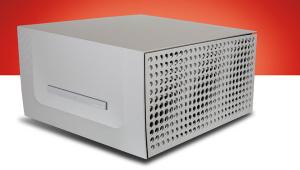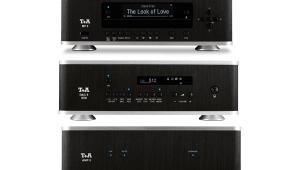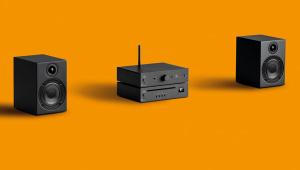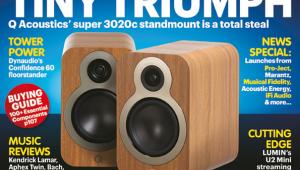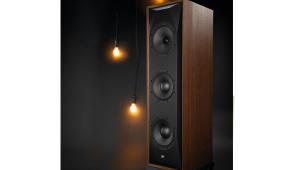Audio Research Reference 80S

 When William Zane (Bill) Johnson opened Electronic Industries as a speciality audio store in Minneapolis back in 1951, little did he know the journey that his custom-built amplifiers would go on. By 1968 he had sold all the patents, the business and himself to another Minneapolis company, before buying everything back two years later to start the Audio Research Corporation that is still in existence today. And so started a cycle of ownership that has seen ARC swapping hands numerous times since the Seventies – being sold to Fine Sounds in 2008, moving under the umbrella of The McIntosh Group in 2016 – before a buyout was finally agreed last September, returning the company to its original independent status and leaving it free to concentrate its efforts on what it does best: producing exceptional tube amplifiers.
When William Zane (Bill) Johnson opened Electronic Industries as a speciality audio store in Minneapolis back in 1951, little did he know the journey that his custom-built amplifiers would go on. By 1968 he had sold all the patents, the business and himself to another Minneapolis company, before buying everything back two years later to start the Audio Research Corporation that is still in existence today. And so started a cycle of ownership that has seen ARC swapping hands numerous times since the Seventies – being sold to Fine Sounds in 2008, moving under the umbrella of The McIntosh Group in 2016 – before a buyout was finally agreed last September, returning the company to its original independent status and leaving it free to concentrate its efforts on what it does best: producing exceptional tube amplifiers.
Throughout this long journey the American concern has resolutely stuck to a couple of core principals. Firstly, its transformers are produced in North America, care of a third-party agreement that ensures it retains decisive control over the sound and consistency of its tube amplifiers. Secondly, everything is hand assembled, hand wired and hand soldered – on which subject, it’s worth noting that despite the use of modern quad-layer boards flow soldering of any kind is avoided at all costs in the Minnesota production facility. And since the buyout, an increasing part of the assembly process has been brought back in-house, or at least kept local. Impressively some staff that had moved on to pastures new have once again returned to the fold, making ARC’s ambition to provide full service for every tube product it has ever made much more achievable.
The latest addition to the company’s Reference series is the 80S you see before you. Though there are clear similarities with other siblings in the range, the genetics of this power amplifier can actually be traced back through a few generations of Audio Research philosophy. Dominated by the etched-onto-acrylic ‘GhostMeters’, the front fascia and footprint of the 80S is clearly in debt to the larger Reference 160M from 2018 and the more recent Reference 160S. These hefty tube amp behemoths also incorporate 6H30 double triodes as phase splitters/drivers alongside bulbous KT150 output tubes – though admittedly twice as many as we have here. They also boast switchable UltraLinear and Triode tube configurations, a theme that’s resolutely carried over into the Reference 80S.
Additional company traits include the four-layer PCBs that first appeared on the Reference 160M/S, although many of the core features that actually inform the sound of the 80S owe much more to the earlier 6H30/KT120-equipped VT80. This was not only the first Audio Research amplifier to employ an auto-bias regime that adjusts for tube age and powerline voltage swings, but its custom-built output transformer went on to become the blueprint for the one that’s currently taking up most of the space in the rear of the Reference 80S before us here.
Like every Reference amplifier before it, the 80S is a fully balanced differential design as ARC believes it provides the highest performance and lowest distortion available. Created for the music lover who does not require the output power of its larger 160S stereo and 160M mono siblings, it’s rated at 70W and the feature set is the same as the 160S.
Connectivity includes single-ended RCA and balanced XLR inputs (a switch lets you toggle between the two), RS-232 and 12V trigger control ports plus 4, 8 and 16ohm speaker output taps. Last but by means least, a small tube hour meter – like an odometer, but for you amplifier – highlights how many hours use the tubes have had.
Sound quality
Initially when the Reference 80S starts up its output is muted for a couple of minutes as the PSU and KT150s cycle up and back down again in order to stabilise the tubes’ temperature and biasing. The first decision you’ll need to consider is hooking up your speakers of choice to the rear 16, 8 and 4ohm speaker taps. This isn’t necessarily straightforward. In Triode mode the best results are achieved with 4ohm nominal speakers connected to the 4ohm tap (circa 40W), however, the same is not true in UltraLinear mode. Here the KT150’s screen grids are connected to an additional transformer winding – the ‘feedback’ squeezing down tube distortion – this configuration enabling the Reference 80S to deliver more power into tougher 4ohm loads from its 8ohm output (~80W) than via its 4ohm tap (~45W).
The same feature was noted in sister magazine Hi-Fi News’ review of the company’s VT80 stereo amplifier. Here, as was the case back then, our reference Bowers & Wilkins’ 800 D3 floorstander purrs most confidently via the Reference 80S’ 8ohm outputs. Nonetheless, the power amplifier commands the necessary presence, and down-to-earth grunt to marshal tremendous sonic forces. Which is good news for our starter test track, a 24-bit/192kHz download of Wagner’s Ring Cycle played by the Duisburger Philharmonic under the baton of Jonathan Darlington. All of the instruments – from violins to oboes and tympani to harps – are sharply drawn so that their union comes across as a richly coloured tapestry rather than a contrasty black-and-white sketch. The result is that the panoramic richness of the 105 players – yep, you read that right – is revealed across a gloriously wide soundscape that brings new meaning to the term panoramic. Meanwhile the chimes and other percussion that make up the Nibelungs’ forging of the ring section of the cycle sound spectacularly vivid. The hollow metallic ringing delivers an incredibly realistic sense of height to the orchestral drama. If you like your classics packing the sort of magnitude that’s ordinarily measured on the Richter scale, the Reference 80S makes for a bombastic choice.
But as we all know, power is nothing without precision and if it can’t replicate those finer details without breaking into a sweat, it becomes just another also-ran. Happily there are no such concerns as the intimacy of Chip Taylor and Carrie Rodriguez’s gorgeous Sweet Tequila Blues adequately demonstrates. Taken from their Let’s Leave This Town long player, this undemanding but sensitively played track shows an entirely different side to the Audio Research. The deft combination of Taylor’s world-weary lament juxtaposed by the punchier quality of his more youthful fiddler and vocalist companion caresses the ears, not so much inviting as compelling the listener to drum their fingers and tap their feet as they’re wrapped in the close, but never cloying, acoustic of this glorious, stripped-back recording. So far so good, but can the Reference 80S rock with the big boys when called upon to do so? You bet it can. Cranking up the volume on the 96kHz remix of Rush’s one-hit wonder The Spirit Of Radio, it’s almost possible to see raw electricity crackling from the speakers as Alex Lifeson’s opening riff sears across the soundstage. Underneath it all Neil Peart’s crashing drums and the backing sequencer unleash the sort of impact and energy you’d expect to have seen if you were lucky enough to have caught the boys live in their heyday. There’s a genuine slam that delivers bass with impressive richness, texture and speed, and – arguably more importantly – the laziness or overhang that you might reasonably expect to hear from a more traditional tube amp is completely absent.
Conclusion
Impressive though Audio Research’s Reference 80S undoubtedly is, there’s a sizeable elephant in the room that should perhaps be put to one side before we go any further. With a £15k price tag, this absolutely isn’t typical HFC fare, which almost immediately puts it out reach of most wallets. Which is a real shame as this is a quite stunning power amplifier that does the easy bit of delivering the power, while handling the more challenging side of subtlety and fine detail with absolute aplomb. In the highly unlikely event that you inadvertently stumble across that lost winning lottery ticket or a rich relative that you never knew about leaves you stacks of cash only on the understanding that you spend them on hi-fi exotica, this is an absolute must-have. For the rest of us it’ll have to remain a dream to aim towards. Regardless, there’s no disputing that the way the Reference 80S delivers the sort of precision that’s more commonly the realm of solid-state rivals from glass tubes is nothing short of miraculous. HFC
DETAILS
Product: Audio Research Reference 80S
Type: Stereo tube power amplifier
FEATURES
● Quoted power output: 70W
● Single-ended RCA; balanced XLR inputs
● 4, 8 and 16ohm output speaker taps
 |
Inside this month's issue:
Ruark R610 music system and Sabre-R standmount speakers, PMC twenty.23i Active, floorstanders, English Acoustics Downton preamplifier, Bluesound NODE ICON preamp/streamer, Ortofon Concorde Music Blue MM cartridge and much, much more
|



